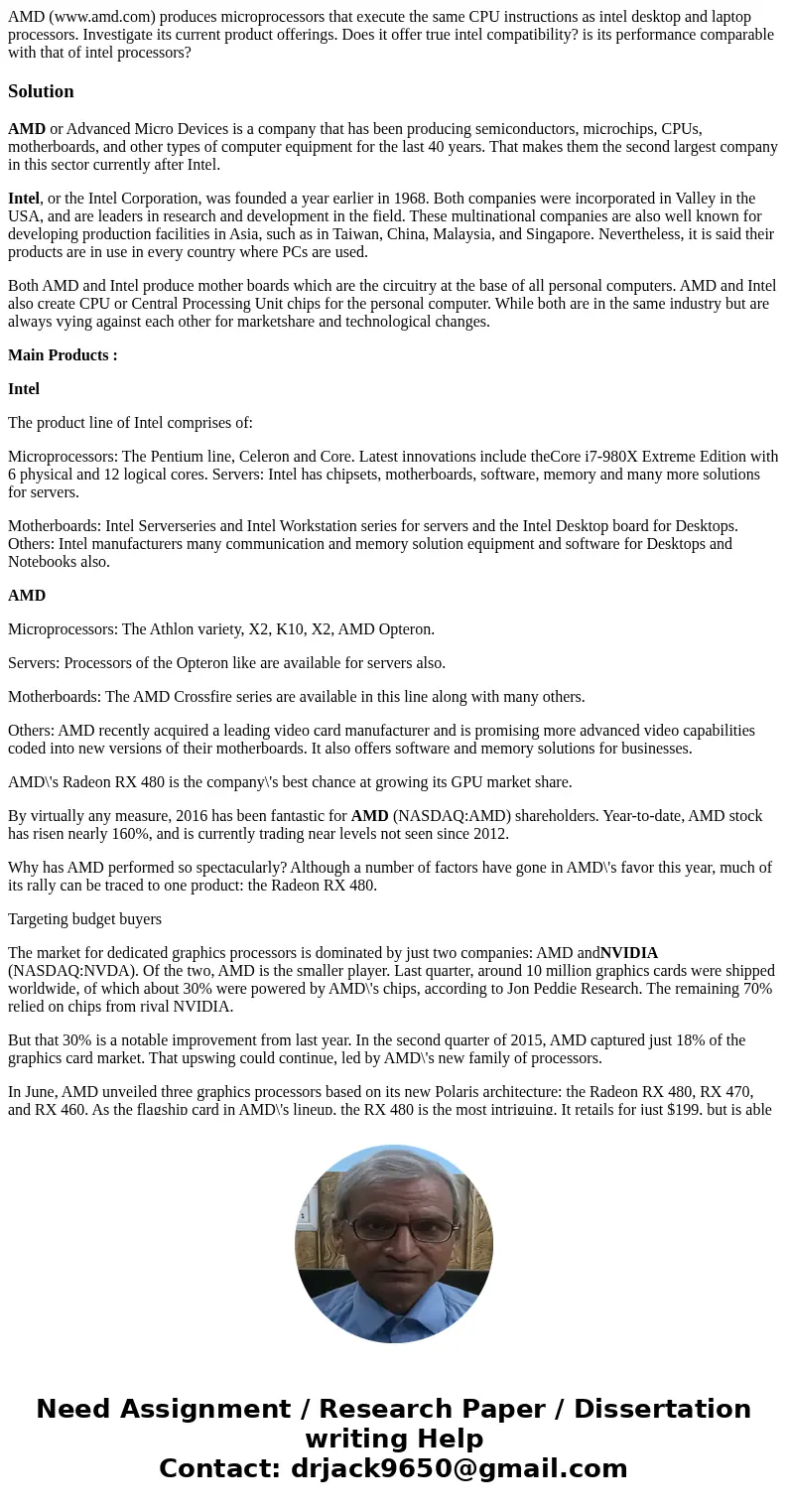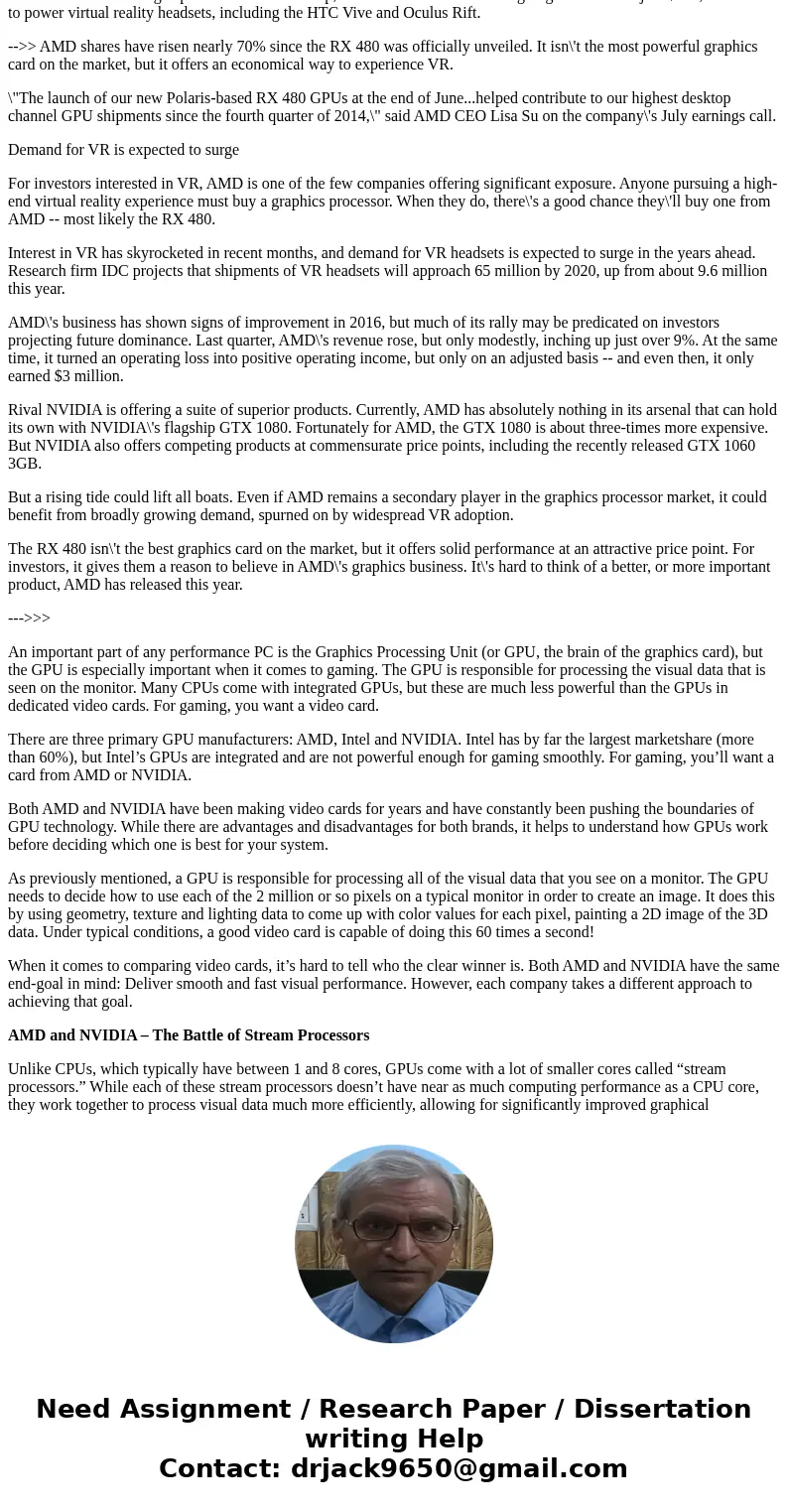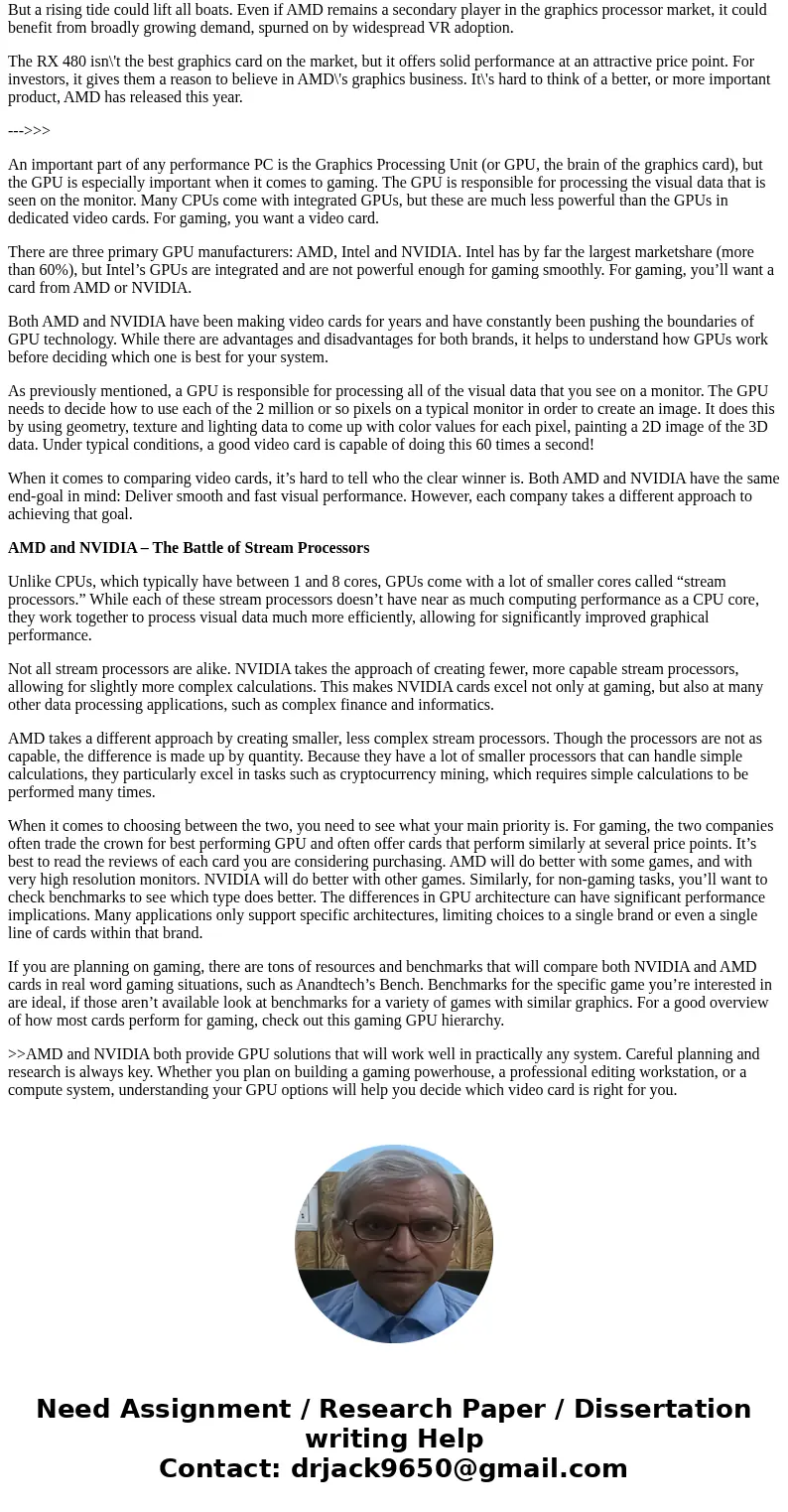AMD wwwamdcom produces microprocessors that execute the same
AMD (www.amd.com) produces microprocessors that execute the same CPU instructions as intel desktop and laptop processors. Investigate its current product offerings. Does it offer true intel compatibility? is its performance comparable with that of intel processors?
Solution
AMD or Advanced Micro Devices is a company that has been producing semiconductors, microchips, CPUs, motherboards, and other types of computer equipment for the last 40 years. That makes them the second largest company in this sector currently after Intel.
Intel, or the Intel Corporation, was founded a year earlier in 1968. Both companies were incorporated in Valley in the USA, and are leaders in research and development in the field. These multinational companies are also well known for developing production facilities in Asia, such as in Taiwan, China, Malaysia, and Singapore. Nevertheless, it is said their products are in use in every country where PCs are used.
Both AMD and Intel produce mother boards which are the circuitry at the base of all personal computers. AMD and Intel also create CPU or Central Processing Unit chips for the personal computer. While both are in the same industry but are always vying against each other for marketshare and technological changes.
Main Products :
Intel
The product line of Intel comprises of:
Microprocessors: The Pentium line, Celeron and Core. Latest innovations include theCore i7-980X Extreme Edition with 6 physical and 12 logical cores. Servers: Intel has chipsets, motherboards, software, memory and many more solutions for servers.
Motherboards: Intel Serverseries and Intel Workstation series for servers and the Intel Desktop board for Desktops. Others: Intel manufacturers many communication and memory solution equipment and software for Desktops and Notebooks also.
AMD
Microprocessors: The Athlon variety, X2, K10, X2, AMD Opteron.
Servers: Processors of the Opteron like are available for servers also.
Motherboards: The AMD Crossfire series are available in this line along with many others.
Others: AMD recently acquired a leading video card manufacturer and is promising more advanced video capabilities coded into new versions of their motherboards. It also offers software and memory solutions for businesses.
AMD\'s Radeon RX 480 is the company\'s best chance at growing its GPU market share.
By virtually any measure, 2016 has been fantastic for AMD (NASDAQ:AMD) shareholders. Year-to-date, AMD stock has risen nearly 160%, and is currently trading near levels not seen since 2012.
Why has AMD performed so spectacularly? Although a number of factors have gone in AMD\'s favor this year, much of its rally can be traced to one product: the Radeon RX 480.
Targeting budget buyers
The market for dedicated graphics processors is dominated by just two companies: AMD andNVIDIA (NASDAQ:NVDA). Of the two, AMD is the smaller player. Last quarter, around 10 million graphics cards were shipped worldwide, of which about 30% were powered by AMD\'s chips, according to Jon Peddie Research. The remaining 70% relied on chips from rival NVIDIA.
But that 30% is a notable improvement from last year. In the second quarter of 2015, AMD captured just 18% of the graphics card market. That upswing could continue, led by AMD\'s new family of processors.
In June, AMD unveiled three graphics processors based on its new Polaris architecture: the Radeon RX 480, RX 470, and RX 460. As the flagship card in AMD\'s lineup, the RX 480 is the most intriguing. It retails for just $199, but is able to power virtual reality headsets, including the HTC Vive and Oculus Rift.
-->> AMD shares have risen nearly 70% since the RX 480 was officially unveiled. It isn\'t the most powerful graphics card on the market, but it offers an economical way to experience VR.
\"The launch of our new Polaris-based RX 480 GPUs at the end of June...helped contribute to our highest desktop channel GPU shipments since the fourth quarter of 2014,\" said AMD CEO Lisa Su on the company\'s July earnings call.
Demand for VR is expected to surge
For investors interested in VR, AMD is one of the few companies offering significant exposure. Anyone pursuing a high-end virtual reality experience must buy a graphics processor. When they do, there\'s a good chance they\'ll buy one from AMD -- most likely the RX 480.
Interest in VR has skyrocketed in recent months, and demand for VR headsets is expected to surge in the years ahead. Research firm IDC projects that shipments of VR headsets will approach 65 million by 2020, up from about 9.6 million this year.
AMD\'s business has shown signs of improvement in 2016, but much of its rally may be predicated on investors projecting future dominance. Last quarter, AMD\'s revenue rose, but only modestly, inching up just over 9%. At the same time, it turned an operating loss into positive operating income, but only on an adjusted basis -- and even then, it only earned $3 million.
Rival NVIDIA is offering a suite of superior products. Currently, AMD has absolutely nothing in its arsenal that can hold its own with NVIDIA\'s flagship GTX 1080. Fortunately for AMD, the GTX 1080 is about three-times more expensive. But NVIDIA also offers competing products at commensurate price points, including the recently released GTX 1060 3GB.
But a rising tide could lift all boats. Even if AMD remains a secondary player in the graphics processor market, it could benefit from broadly growing demand, spurned on by widespread VR adoption.
The RX 480 isn\'t the best graphics card on the market, but it offers solid performance at an attractive price point. For investors, it gives them a reason to believe in AMD\'s graphics business. It\'s hard to think of a better, or more important product, AMD has released this year.
--->>>
An important part of any performance PC is the Graphics Processing Unit (or GPU, the brain of the graphics card), but the GPU is especially important when it comes to gaming. The GPU is responsible for processing the visual data that is seen on the monitor. Many CPUs come with integrated GPUs, but these are much less powerful than the GPUs in dedicated video cards. For gaming, you want a video card.
There are three primary GPU manufacturers: AMD, Intel and NVIDIA. Intel has by far the largest marketshare (more than 60%), but Intel’s GPUs are integrated and are not powerful enough for gaming smoothly. For gaming, you’ll want a card from AMD or NVIDIA.
Both AMD and NVIDIA have been making video cards for years and have constantly been pushing the boundaries of GPU technology. While there are advantages and disadvantages for both brands, it helps to understand how GPUs work before deciding which one is best for your system.
As previously mentioned, a GPU is responsible for processing all of the visual data that you see on a monitor. The GPU needs to decide how to use each of the 2 million or so pixels on a typical monitor in order to create an image. It does this by using geometry, texture and lighting data to come up with color values for each pixel, painting a 2D image of the 3D data. Under typical conditions, a good video card is capable of doing this 60 times a second!
When it comes to comparing video cards, it’s hard to tell who the clear winner is. Both AMD and NVIDIA have the same end-goal in mind: Deliver smooth and fast visual performance. However, each company takes a different approach to achieving that goal.
AMD and NVIDIA – The Battle of Stream Processors
Unlike CPUs, which typically have between 1 and 8 cores, GPUs come with a lot of smaller cores called “stream processors.” While each of these stream processors doesn’t have near as much computing performance as a CPU core, they work together to process visual data much more efficiently, allowing for significantly improved graphical performance.
Not all stream processors are alike. NVIDIA takes the approach of creating fewer, more capable stream processors, allowing for slightly more complex calculations. This makes NVIDIA cards excel not only at gaming, but also at many other data processing applications, such as complex finance and informatics.
AMD takes a different approach by creating smaller, less complex stream processors. Though the processors are not as capable, the difference is made up by quantity. Because they have a lot of smaller processors that can handle simple calculations, they particularly excel in tasks such as cryptocurrency mining, which requires simple calculations to be performed many times.
When it comes to choosing between the two, you need to see what your main priority is. For gaming, the two companies often trade the crown for best performing GPU and often offer cards that perform similarly at several price points. It’s best to read the reviews of each card you are considering purchasing. AMD will do better with some games, and with very high resolution monitors. NVIDIA will do better with other games. Similarly, for non-gaming tasks, you’ll want to check benchmarks to see which type does better. The differences in GPU architecture can have significant performance implications. Many applications only support specific architectures, limiting choices to a single brand or even a single line of cards within that brand.
If you are planning on gaming, there are tons of resources and benchmarks that will compare both NVIDIA and AMD cards in real word gaming situations, such as Anandtech’s Bench. Benchmarks for the specific game you’re interested in are ideal, if those aren’t available look at benchmarks for a variety of games with similar graphics. For a good overview of how most cards perform for gaming, check out this gaming GPU hierarchy.
>>AMD and NVIDIA both provide GPU solutions that will work well in practically any system. Careful planning and research is always key. Whether you plan on building a gaming powerhouse, a professional editing workstation, or a compute system, understanding your GPU options will help you decide which video card is right for you.



 Homework Sourse
Homework Sourse